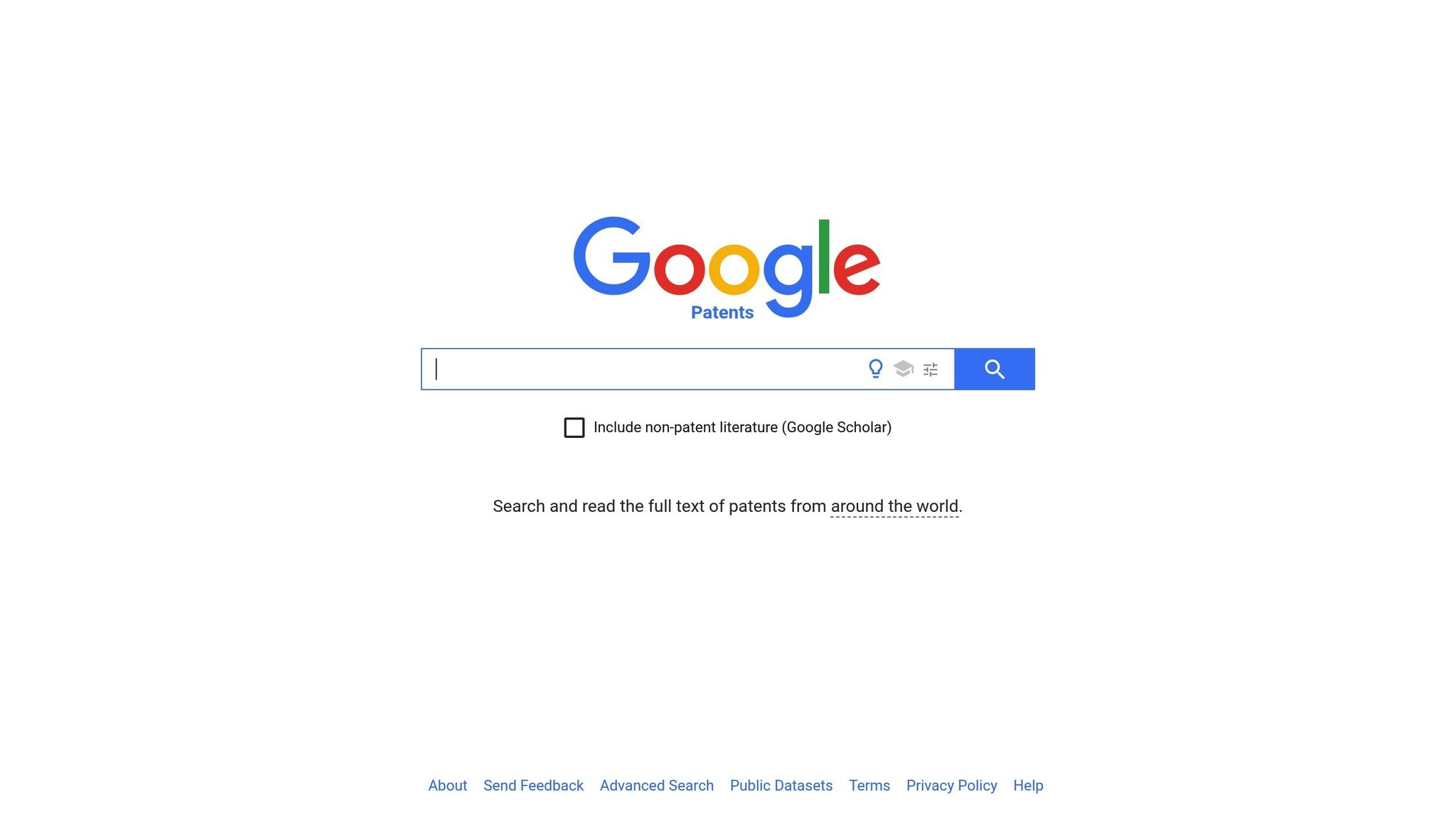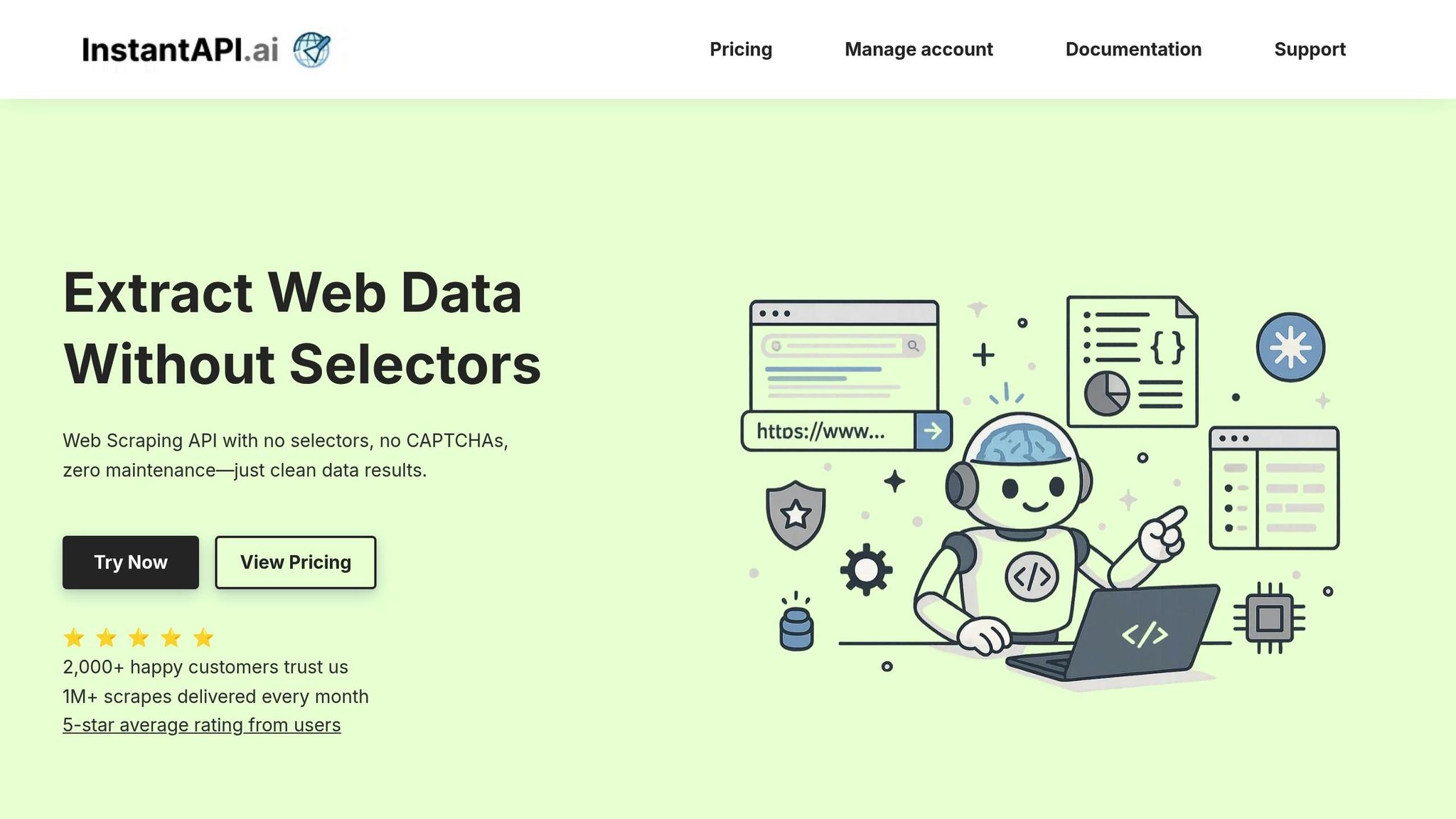Web scraping lets firms track patents and tech shifts by pulling data from sites like USPTO and Google Patents. It cuts time, lowers mistakes, and shines light on rivals, changes in the trade, and chances to make new things. Here's how it runs and why it counts:
- What It Does: Makes pulling data (like, patent names, dates they were filed, who made them) into forms like CSV or JSON easy.
- Why It Matters: It aids in watching rivals, dodges legal traps, and spots market shifts.
- Main Tools: USPTO, Google Patents, PatentsView, and Espacenet for patent info; study texts and tech news for wider ideas on new things.
- Best Tools: Python's Scrapy for fast work, Selenium for sites heavy with JavaScript, and InstantAPI.ai for simple, no-code scraping.
Quick Tip: Use tools like InstantAPI.ai ($2/1,000 pages) for low-cost, automated, and sure scraping of patent data. Always stick to legal rules like CFAA and look at robots.txt to keep out of trouble.
How to scrape google patents using python

Main Ways to Follow Patent and New Tech Info
Keeping an eye on tech changes and smart choices depends on good info sources. Most of the time, U.S. sources are the ones you'll use for the best info, but world-wide data also helps in seeing big patterns.
Top Sources for Patent Info
The U.S. Patent and Trademark Office (USPTO) is a key place for U.S. patent facts. It might not be easy to use, but it has the newest and most correct patent details.
Google Patents makes looking up patent info easy, with a list of 87 million patents from 17 places. It's great for finding things like patent names, when they were filed, details, and bits of content in a clear way.
If you want more on U.S. patents, PatentsView is good too. It has 50 years of patent info, and shows inventors, their groups, and where they are. It's very good for tracking real patents and those not granted yet, with facts up to March 31, 2025.
For world-wide views, Espacenet covers patents from 97 places and has over 110 million patents. It also translates, so you can see trends outside the U.S. that might matter.
While these are great for patent data, they don't show everything. You need more to see all about new tech.
More Ways to Get Info on Innovations
Patent files are only part of the story. To find new tech trends early, look at other places like research papers, company news, and media that follows new tech.
- Research papers: Spots like MIT Technology Review and IEEE papers often talk about new tech before it's patented. They are good for seeing where tech is going.
- Company blogs and press releases: Big names like Google, Microsoft, and Apple often tell about their new tech before they file patents. This gives hints at what's coming next.
- Innovation aggregators: Places like TechCrunch and VentureBeat keep tabs on funds, new products, and teams, showing what tech is getting attention and money.
It's cool that about 80% of patent info can’t be found elsewhere, so these other spots are key for a full view of tech trends.
Checking How Good Your Info Sources Are
With so many places to get info, it's key to check if they're good. Think about if they're accurate, fitting, and believable. Government spots like the USPTO and PatentsView are often the best, but other places bring extra useful points.
To pick info wisely, think about using tools like the WIPO's INSPIRE tool which fits your needs with the right databases. This makes sure you're not looking at stuff that doesn’t help.
When you check a source, think:
- Is it right and up to date?
- Can you get the data from it all the time?
- Has it been good and reliable before?
Basic Ways to Get Data from the Web
To pull patent and new tech data, you need the right set of tools and plans. A bad choice might mean a lot of fixing and care woes, so it’s good to look at your choices with care.
Python Tools for Expert Users
For fixed patent lists, Scrapy is a great pick. It works fast and well - tests tell us Scrapy can pull 1,000 files in just 31.57 seconds, way quicker than Selenium’s 156.01 seconds. That's a big time edge. But, Scrapy finds it hard to deal with new, JavaScript-rich sites. Many tech tracking sites use things like non-stop loads, long scrolls, or click parts, which Scrapy can't work with. For example, Google Patents' deep search often makes it hard for this tool.
When you need to work with moving pages or JavaScript-rich sites, Selenium is the way to go. Selenium runs a full web browser, so it can deal with tough tasks like going through patent type menus or waiting for search results to show up. It fits with many coding forms, but it’s slow. What Scrapy does fast, Selenium does slow. Plus, often changes to site HTML can mess your scrap scripts, making more work to keep up.
These downs mean newer, smoother answers have come up.
Making Web Scraping Easy with InstantAPI.ai

Here comes InstantAPI.ai, which flips the script on web scraping. You don’t write and keep up selectors. Just say what data you need in simple terms. The service does the rest.
"AI powered web scraping has long been considered the Holy Grail of data extraction. This technology promises accurate, efficient extraction with minimal code." - ScrapeOps
When you track patents, you can ask for info like "patent name, date it was filed, names of those who made it, and a short summary" from any place that stores data without having to write tricky code. InstantAPI.ai also deals with common problems in scraping such as changing proxies, solving CAPTCHA, and managing JavaScript - all by itself. At only $2 for every 1,000 pages, it’s a cheap choice for both little jobs and big ones that watch over time. It offers many ways to see your data (JSON, Markdown, plain HTML) and can change its layout on its own to keep your scraping work going, even when sites change how they look.
Common Problems with Scraping Web Pages from US Sites
Picking the right tools is one step, but scraping sites in the US brings its own issues:
- CAPTCHAs: Many important databases have CAPTCHA systems. Making your own fix for these can be dodgy and take a long time. Now, new tools handle CAPTCHA for you, making life easier.
- Infinite Scroll: Sites that keep loading new stuff as you scroll can trip up old scrapers. Using tools that can pretend to scroll like a person and wait for the page to load is what you should do.
- JavaScript: A lot of today's patent places, such as PatentsView and Google Patents, use a lot of JavaScript. Simple web requests won’t work here. You need tools that can run JavaScript and wait for stuff to show up.
-
Rate Limits and IP Blocks: Places like the USPTO often have strict rules on how much you can scrape and may block your IP. Using many IPs through a professional proxy service can help, but managing these can get complicated and pricey. Always check the site’s rules in the
robots.txtfile and their terms before you start scraping.
A good plan to beat these problems includes randomizing your requests - change headers, user identities, and timing - and try to copy how humans browse. For instance, scrape when fewer people are online and space out your requests to not flood the site’s servers. These methods boost your chance of success and are also more ethical ways to scrape.
sbb-itb-f2fbbd7
Step-by-Step Guide to Building a Patent Tracking Pipeline
"Set clear goals to make it much easier to track patents."
Steps to Build Your Pipeline
First, know what you want from your pipeline. Why are you setting it up? What data do you need? Once you have answers, find where this data lives.
Getting the Right Tools and Setting Up
After you know your goals and data sources, pick tools that fit your need. Set up these tools to start your tracking. As you get rolling, always check that your tools blend well with your current systems.
"A robust search strategy isn't just about collecting data - it's about gathering the right data."
Your aims will set what your work looks like. Are you checking on what other groups file for to see where they might go next with products? Or are you keeping an eye on new tech in your area? Maybe you are looking for deals on using tech? Each goal needs its own ways to get info and tools for pulling data.
To make sure you win, set clear targets like: "Watch how top 10 tech companies file machine learning patents, with a focus on how they process human speech, over the last six months." These clear points will help you pick where to get data and how to pull it.
For tracking patents in the US, the best tools include:
- USPTO database: It has the most full official info.
- Google Patents: Easy to search and covers stuff from all over.
- PatentsView: Great for looking at who cites what.
Also, look at places like news from companies, work from schools, and tech news on websites. Many big new ideas are talked of here first, long before they turn up in patent files.
The key to a good work flow is to match your data spots with your aims. Say you want to know about early ideas, school databases and blogs might tell you more than patent files. But if you want to know what your rivals are up to, look at their latest patent files and steps in making things.
Setting up InstantAPI.ai for Tracking Patents
Once you know your goals and where to get data, set up your tool to meet these needs. With InstantAPI.ai, you can make a JSON setup for the patent parts you need, and the tool does the pulling part.
For full tracking, your setup might have parts like:
- Patent title
- Date of filing
- Creators
- The owner company
- A brief summary
- Claim count
- Its current state
Here’s what to do: Aim the API at a USPTO patent page, give it your setup. InstantAPI.ai deals with the tough parts of web, handles changes, and gives you clean JSON data. For $2.00 per 1,000 pages, this lets you handle lots of patent info cheap.
To always watch certain groups or tech, set the API to run over and over. InstantAPI.ai keeps up with changes in how patents are shown, so you do not have to keep fixing things by hand.
For deep searches, use the /search path to pull stuff from Google Patents. You might search for things like "artificial minds AND self-driving cars" to cover a lot, then dig into the patents that come up. The tool handles all web tricks like endless pages and codes you need to fill in, making sure your data pulling stays smooth.
Adding to US-Based Data Works
Once you’ve set up how to pull data, you have to add it to your systems for making sense of info. This needs you to be sharp about how you sort and follow rules.
Most data works in the US use tools like Snowflake, Databricks, or AWS Redshift to keep data. InstantAPI.ai’s JSON fits right in with these using normal steps for moving data. But, you need to make sure that:
- Dates are written as MM/DD/YYYY.
- We use the dollar sign ($), and measure things in inches, feet, and pounds, like they do in the US.
- We make sure the same names and company IDs are used in all our data.
Checking data is key. Put tests in your system to find mistakes like wrong patent numbers, missing dates, or the same records twice. Spotting things that don't look right early on stops problems that could mess up what you find out.
It's vital to watch your system all the time to keep it running well. Write down every API call, change, and mix. Set alerts for weird stuff, like a big drop in patent files or too many failed tries. This active way stops problems before they mess up what you're working on.
Don't forget about rules on keeping data. Patent info is useful for a long time to see trends, but you might need to handle inventor details with care. Set up your storage and backups to meet needs now, and also for studies in the future.
Start by making your data look the same. Change dates to one style, use one list for company names, and make unique IDs for patents that work with many data sets. Doing this makes it simpler to mix patent info with other facts for business, and increases the worth of what you learn.
Looking at Ways to Scrape Web Data for Keeping an Eye on Patents
Picking the right way to scrape web data is key to track patent info well. The best method balances how hard it is to set up, how it can grow, upkeep, and cost, making sure you can watch closely and make smart choices.
Python Setups Made at Home
Python tools made on your own, like Scrapy and Requests, let you change things as needed but need a lot of upkeep. Teams have to handle proxy changes, break CAPTCHAs, and tweak data grabbing points when site designs change. These constant issues often push groups to look for more hands-off options.
Tools That Need No Code
Tools that scrape data without needing code seem easy because they are simple but may fall short when facing tricky things like endless pages or strong bot blocks.
Proxy Services Only
Proxy services help get past site blocks, but you still must handle data grabbing and sorting on your own. This way still needs lots of hands-on work.
Common Scraping SaaS Platforms
Web scraping through SaaS makes some things easier but can get pricey with changing data amounts, especially if you're working with anywhere from hundreds to many thousands of patent pages.
InstantAPI.ai
InstantAPI.ai streamlines the whole scraping job. With little setup, it takes care of picking data points, managing proxy changes, solving CAPTCHAs, and handling JavaScript. Prices? Just $2.00 for 1,000 pages, so doing 10,000 patent pages costs about $20. This makes it a low-cost and flexible choice, good for projects big and small.
Dealing with US-Specific Issues
Watching patents in the US brings special challenges, like local data styles. The right tools have to read American date styles (MM/DD/YYYY), deal with dollar values right, and work well with sites like USPTO and Google Patents. Tools that adjust to these needs on their own save time and cut mistakes.
Staying Reliable and Adapting
Being reliable is vital when you're keeping watch on urgent patent filings. Old setups can break when sites add new CAPTCHAs or change how they load data (like endless pages). For instance, in July 2024, a Python code using ZenRows got past the bot block of ScrapingCourse.com by using better proxies and handling JavaScript. This shows the worth of tools that adjust that lessen the need for manual fixes when sites boost their guards.
End Thoughts and Smart Ways
Main Points
Web scraping has changed how we track patents, from slow, manual effort to fast, automated systems that give quick and helpful info. The key to doing well is to use the right tools with a smart plan, picking cost-saving and stable options over ones that are too tricky.
For instance, InstantAPI.ai stands out for tracking patents, giving organized JSON data at only $2.00 for every 1,000 pages. This price is good for both small study work and big company watch jobs, letting users follow lots of patent info without spending too much.
When keeping an eye on U.S. patents, tools must fit local needs (like MM/DD/YYYY for dates and USD for money) and work well with places like the USPTO and Google Patents. Auto features cut out the tech barriers that used to slow things down, making the process smoother.
The main gain is getting insights fast. With new data coming to people in days, firms can stay in front when checking urgent patent files or spotting new tech trends. This speed helps make better, quicker choices, key for staying on top in tracking innovations.
To keep up these perks, here are good ways to make sure your web scraping works well.
Top Practices for Web Scraping
1. Use trusted data spots.
Stick to known spots like official patent places and tech vaults. Double-checking info from different spots means better accuracy and less mistakes.
2. Go by the rules. Always follow site rules, including robots.txt files and user terms. Scraping the right way - like during slow times, switching IPs, and trying again if needed - keeps you from being blocked from important data.
3. Get ready for site updates.
Sites often change how they look, which can mess up scraping plans. Use tools that can handle these changes and test your systems often to find and fix issues before they mess up your data.
4. Grow your work smartly.
Know what data you need first and pick tools that can expand with your work. With web scraping experts in the U.S. making about $59.01 per hour as of October 2024[1], automatic options are cheaper than doing it by hand.
5. Make your data clean and standard.
Raw data can be messy or missing things. Fixing and making it regular fits your systems better and boosts your study quality. Well-set data opens up insights that push smarter innovation paths and better market smarts.
FAQs
How can companies use data from web scraping to get better at making choices?
Companies can make web scraping data easier to use by setting up automatic systems that do jobs like checking, cleaning, and putting data into easy-to-use forms like CSV or JSON. This way, the data works right away with data warehouses, data lakes, or other places to keep data.
Once the data is put in the right way, it can be worked on and looked at with tools for business intelligence (BI) or models for machine learning to find trends and useful bits of info. Making these steps automatic not only cuts down on work by hand but also helps with choices made right now, letting businesses stay ahead in the race and make smart, planned decisions.


